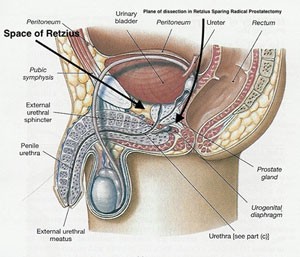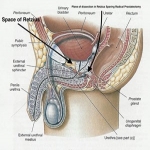I am pleased to offer robotic assisted Retzius Sparing Radical Prostatectomy to suitable patients with prostate cancer required surgical treatment. 
This is a new technique which was originally developed by Professor Bocciardi from the Ospedale Niguarda in Milan, Italy. The main advantage of this technique is improved outcomes in preservation of urinary continence and sexual potency. Peer reviewed publications of this technique have reported immediate continence (no pads required at all) in 92% of patients after catheter removal. With the conventional technique most patients will have incontinence after surgery and their continence will slowly improve over 12 months with pelvic floor exercises.
The space of Retzius is a area bound by the pubic bone in front and the bladder and prostate behind. The floor of this space is made up of strong ligaments that hold the prostate to the pubic bone (puboprostatic ligaments) and sheets of fascia that cover the pelvic floor bilaterally (endopelvic fascia). These structures are crucial for maintaining continence in men. In conventional radical prostatectomy the space of Retzius is dissected out and the puboprostatic ligament and the endopelvic fascia are divided in order to access the prostate.
With the Retzius sparing radical prostatectomy approach the Space of Retzius, puboprostatic ligaments and the endopelvic fascia structures are undisturbed, the prostate is accessed from behind through a smaller incision of the peritoneum between the prostate and colon. This technique is very difficult to perform with traditional open surgery. The magnification and precision of the Da Vinci robotic surgery platform has allowed for this new technique to be carried out safely.
The Retzius sparing technique is particularly useful for patients with early prostate cancer. In patients with extensive prostate cancers, in particularly cancers located around the anterior part of the prostate gland near the space of Retzius, this technique may not be suitable due to the increased risk of incomplete resection of prostate cancer.

